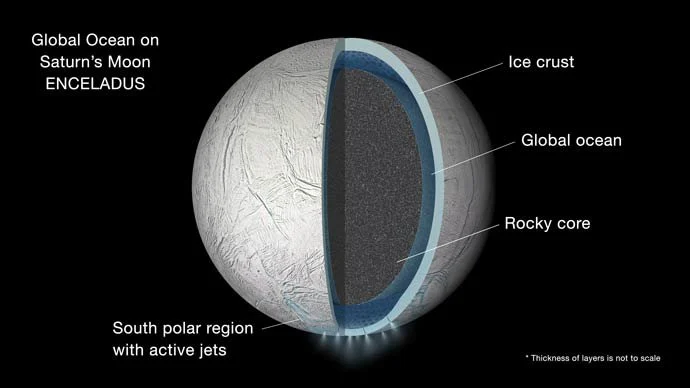
What can the pH level of the subsurface ocean on Enceladus tell us about finding life there?
This is what a recent study accepted to Icarus hopes to address as a team of researchers investigated the potential pH level of Enceladus’ subsurface ocean based on current estimates.
This study has the potential to help scientists better understand the composition of Enceladus’ subsurface ocean and what this can mean for finding life as we know it.
For the study, the researchers used computer models to estimate the pH levels of the subsurface liquid water ocean based on data regarding phosphate levels in ice grains that were discharged from Enceladus’ plumes at the moon’s south polar region.
This data was obtained when NASA’s Cassini spacecraft flew through the plumes during its historic mission after it discovered the plumes existed.
In the end, the researchers’ models estimate that Enceladus’ ocean has pH between 10.1-11.6, which they note is higher than longstanding estimates between approximately pH 8-9.
The researchers then postulated if the estimated pH in the plumes was the same as the pH within the ocean and the processes responsible for changing it.
Based on Earth processes, the researchers postulated that carbon dioxide degassing within Enceladus’ ocean could increase the pH when it’s discharged via the plumes.
The researchers concluded that the carbon dioxide degassing is too small to cause large increases in pH, ultimately estimating the ocean’s pH is approximately 10.6.
For context, a pH of 7 is considered neutral with fully acidic being 0 and fully alkaline being 14.
The average pH of Earth’s water ranges between 6-8.5, freshwater ranging between 6.5-8, rainwater is approximately 5.6, and seawater is approximately 8.2.
The study notes, “Our new understanding of the pH of Enceladus’s ocean and how volatile signatures are transferred between the ocean and plume have important implications. High pH ocean water is evidence of a strong degree of interaction between chemically basic rocks and the ocean of Enceladus.”
Discovered in 1789 by William Herschel, Enceladus is the sixth-largest moon of Saturn and the 18th largest moon in the solar system.
For context, the Earth’s Moon is approximately one-quarter the diameter of Earth and Enceladus is approximately one-seventh the diameter of the Earth’s Moon.
While Enceladus was briefly explored during the flybys of NASA’s Voyager 1 and Voyager 2 spacecraft in 1980 and 1981, respectively, it wasn’t until NASA’s Cassini spacecraft arrived in the Saturn system and began conducting several flybys of Enceladus in 2005.
During these flybys, Cassini discovered the plumes that emanated from Enceladus’ south pole regions called “tiger stripes”, which were named due to the large scar-like cracks where the plumes were discharged, ultimately discovering more than 100 geysers.
Cassini even flew through the plumes to ascertain their composition, discovering water vapor, molecular hydrogen, organic hydrocarbons and molecules like methane, ethane, oxygen, and nitrogen. The phosphates that were examined for this study were first discussed in a 2023 study published in Nature based on data collected by Cassini’s Cosmic Dust Analyzer instrument.
Cassini officially “retired” in 2017 when it was intentionally burned up in Saturn atmosphere to avoid contaminating moons like Enceladus with Earth-based microbes. However, scientists continue to pour over large amounts of data the pioneering spacecraft obtained about Enceladus while gaining greater insight into this intriguing ocean world.
While future missions to Enceladus have not been accepted, the Enceladus Orbilander is a current mission concept that is gaining steam in the scientific community for its promise to teach us more about Enceladus in greater detail than Cassini was capable of doing.
This will include conducing in-depth analyses of Enceladus’ plumes and land a probe on Enceladus’ surface with the goal of ascertaining the habitability of this small moon and whether there’s life as we know it.
What new discoveries about the pH level, and other aspects, of Enceladus’ subsurface ocean will researchers make in the coming years and decades? Only time will tell, and this is why we science!
As always, keep doing science & keep looking up!
Written by Laurence Tognetti/Universe Today.



